Click here to print
“Race Films” – Little-Known Screen Gems
posted August 12, 2016
“Race films” were made with African American actors and crews, and for the most part by African American directors and producers; they were popular with African American audiences from the 1920s to the 1940s, but are little known, now.
That may change through the efforts of several moving-image archives and the distributor Kino Lorber, which has just released in the United States the home-video versions of high-definition digital restorations of many “race films,” in a deluxe box of five DVDs or Blu-rays titled Pioneers of African-American Cinema. (UK release will come in the northern autumn.)
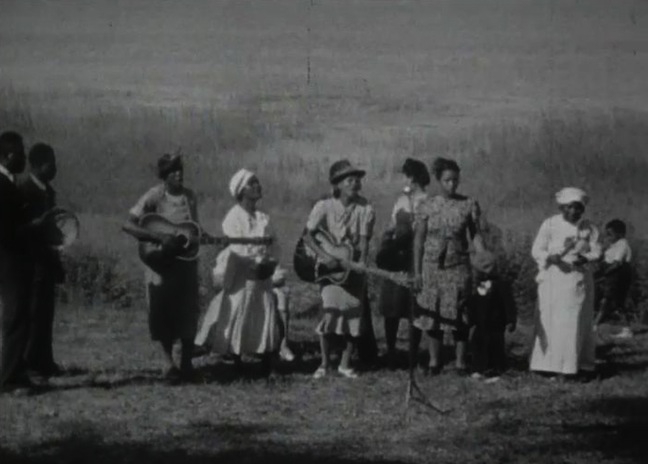
Fieldwork Footage, by Zora Neale Hurston, 1928
n
The set, which Kino Lorber is billing as “the most comprehensive collection of early African-American cinema ever assembled,” includes more than a dozen silent and sound feature films by pioneering directors, such as Richard Maurice, Spencer Williams, and perhaps most notably Oscar Micheaux, as well as rarely-seen footage shot by writer Zora Neale Hurston (see, above), and a good deal more. For comparison, the producers have included work by white directors of “race films” including Richard E. Norman and Frank Peregini.
And, to illustrate what Jacqueline Najuma Stewart, a professor of cinema and media studies at the University of Chicago calls “the diversity of Black filmmaking prior to the Civil Rights Era,” the producers of the box set have included many shorts, rare fragments, trailers, documentary footage, home movies, and interviews with historians and film preservationists. An outstanding 80-page booklet with essays and film notes accompanies the set.
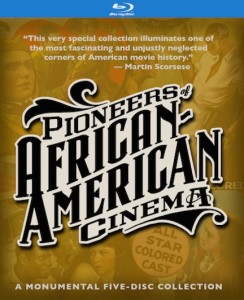 The Kino Lorber film package results from a collaboration by several institutions. Taking part in preparing the films were the U.S. Library of Congress, the British Film Institute, George Eastman Museum, Museum of Modern Art, U.S. National Archives, National Museum of African American History and Culture, Southern Methodist University, and the UCLA Film & Television Archive. Funding was raised in part by a 2015 crowd-funding campaign via the Kickstarter donations platform. (Kino Lorber issued a short promo about that project, last year [2015].)
The Kino Lorber film package results from a collaboration by several institutions. Taking part in preparing the films were the U.S. Library of Congress, the British Film Institute, George Eastman Museum, Museum of Modern Art, U.S. National Archives, National Museum of African American History and Culture, Southern Methodist University, and the UCLA Film & Television Archive. Funding was raised in part by a 2015 crowd-funding campaign via the Kickstarter donations platform. (Kino Lorber issued a short promo about that project, last year [2015].)
The Library of Congress and other archives provided high-definition master film elements. Those are among the relatively few race films to have survived deterioration, loss, and neglect, over the decades. (In the case of some films, sections were included that have not been fully restored – could not be fully restored, due to deterioration of nitrate film stock; the argument in favor of including those films is that enough restorable surrounding footage was available to permit narratives to be well understood.)
A trailer for the series provides a sense of the great stylistic diversity of the films, and their visual surprise.
“Race films” differed from a variety that Hollywood studios made with black actors, called “black cast films.” Those were primarily targeted at white audiences, while “race films” were “exemplary American films” by makers who often were determined to “take up thorny ethical and political questions, while taking bold stylistic risks,” writes Jacqueline Najuma Stewart, a film historian at the University of Chicago, in an essay in the new set’s accompanying booklet.
The phenomenon of “race films” arose from such historical developments as the Harlem Renaissance, the artistic and intellectual ferment of the 1920s and 1930s centered on Harlem, New York, writes Paul D. Miller, the set’s executive producer, in his introduction to the Pioneers of African-American Cinema set: “African-American culture was moving into warp speed with the prototype of the Harlem Renaissance, and the reclamation of identity through a cinema that acknowledged the trauma of the past and present to re-imagine the infinite possibility of a free future.”
Among the most striking features of the films, he notes, is that pioneering black filmmakers “imagined a new realm for African Americans to experience — a world that was often far ahead of reality.”
Charles Musser takes up this point in his introductory essay in the booklet. Racial segregation was severe, such that “W.E.B. Du Bois could write of two worlds, one white and one black,” and of black Americans often possessing a “double-consciousness” of their own race within larger society. Race cinema, however, “left behind the world of white America,” he says, and, as Du Bois put it, “stepped within the Veil, raising it so that you may view faintly its deeper recesses.”
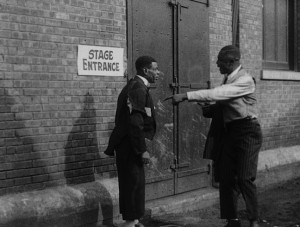
In the Ebony Film Co.’s “Two Knights of Vaudeville,” made in 1915, three friends find their way into a vaudeville performance, only to find that they are not the kind of clientele the management prefers, so they are escorted out.
Sure, Musser says, the view of African-American life that the films provided was “highly mediated by the conventions of melodrama, comedy, and adventure as well as cinema itself,” but the films could also constitute “an important source of entertainment and cultural sustenance.”
Musser, a film historian at Yale University who curated the package, and who co-edited the essay collection Oscar Micheaux and His Circle: African-American Filmmaking and Race Cinema of the Silent Era, cites Luther Pollard, a manager, producer, and director who proudly stated that his films “proved to the public that colored players can put out good comedy without any of that crap shooting, chicken stealing, razor display, water melon eating stuff that the colored people generally have been a little disgusted in seeing.”
Vaudeville houses, and then the cinemas that evolved from them, were not spaces where black Americans could be comfortable. A variety of the film makers, and Oscar Micheaux most of all, engaged such demarcations of the “color line” by, for example, presenting characters who were racially ambiguous, or by recasting for black audiences plays that, while they included black actors, were intended for white audiences.
In one film, writes Musser, Micheaux “probes the complex psycho-dynamics around the act of passing” – purposely appearing to be of a race that, in conventional terms, one was not. In such ways Micheaux sought “to generate conversations about the color line on each side of that divide.” Doing that, he often perturbed audiences, critics, and cultural commentators, black and white.
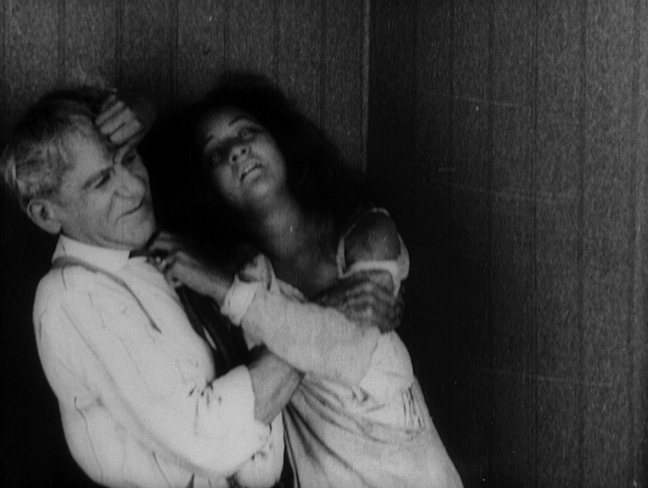
From “Within Our Gates,” by Oscar Micheaux, 1915.
n
Micheaux made about 21 silent films between 1919 and 1930, of which only three survive. Those are all in the Kino Lorber package and were, writes Musser, “serious melodramas that engaged the color line.” In the earliest surviving feature by a black director, Micheaux’s Within Our Gates, from 1919, Evelyn Preer, a key figure in “race films,” plays a young woman who has followed the Great Migration from the rural South to the urban North. The film contains a lynching scene, which led the Chicago Board of Movie Censors for a time to bar it, for fear of rioting; then, when the ban was lifted, black activists objected to the realistic depiction.
In Micheaux’s 1939 feature, Birthright, a Harvard graduate returns to the South to set up a school, but is opposed by both white and black citizens.
Among other films in which directors dared to offend “the more respectable class of African-American theatergoers,” Musser writes, was Dirty Gertie from Harlem U.S.A., Spencer Williams’s 1946 retelling of W. Somerset Maugham’s short story “Miss Sadie Thompson,” which had been the basis of Rain, a 1932 film starring Joan Crawford.
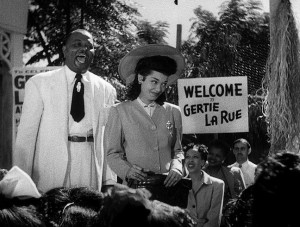 Gertie la Rue is a nightclub singer (played by Fancine Everett, left and below left) who goes to a Caribbean island that black people both populate and run to entertain American troops and to try to elude an embittered lover. There, a self-righteous missionary tries to drive her away. The film “embraces a distinct form of black sociability and savors transgressive black behavior,” writes Musser. Micheaux’s “black spaces” were never self-contained, and instead always were constructed to make points about race constructions and relations, he notes.
Gertie la Rue is a nightclub singer (played by Fancine Everett, left and below left) who goes to a Caribbean island that black people both populate and run to entertain American troops and to try to elude an embittered lover. There, a self-righteous missionary tries to drive her away. The film “embraces a distinct form of black sociability and savors transgressive black behavior,” writes Musser. Micheaux’s “black spaces” were never self-contained, and instead always were constructed to make points about race constructions and relations, he notes.
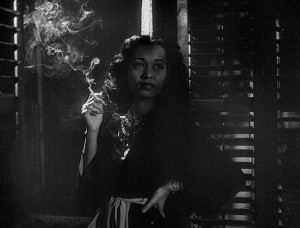 That was not the approach of most directors of “race films,” he says. Most avoided directly engaging those sorts of issues, as much to avoid the disapproval of black cultural gatekeepers as to dodge confrontation from American society, at large. But even when the films did not challenge the color line, they often served as alternatives to Hollywood fare, and the color line could serve as “a line of defense, used to create space for black social life.” Then, African Americans could “function culturally, socially, and economically with a relative degree of independence.”
That was not the approach of most directors of “race films,” he says. Most avoided directly engaging those sorts of issues, as much to avoid the disapproval of black cultural gatekeepers as to dodge confrontation from American society, at large. But even when the films did not challenge the color line, they often served as alternatives to Hollywood fare, and the color line could serve as “a line of defense, used to create space for black social life.” Then, African Americans could “function culturally, socially, and economically with a relative degree of independence.”
True, writes Jacqueline Najuma Stewart, but it should be borne in mind, she says, that “race movies made up a rather small percentage of films that Black viewers consumed during the era of Jim Crow segregation.” Black audiences predominantly viewed mainstream films “with their attendant exclusion, denigration, and/or exoticization of Black subjects.”
And so, writes Stewart, a film historian at the University of Chicago who wrote the 2005 study, Migrating To the Movies: Cinema and Black Urban Modernity, “I would argue that the frequent construction of ‘race films’ as constituting a separate “Black” public sphere can be misleading, not just because Black audiences, filmmakers, and performers were in active engagement with Hollywood films, but also because of the extensive involvement of white people throughout Black film culture.”
She echoes Musser in saying that a strong sentiment among elite and middle-class Black activists was that popular entertainments should advance a cause of “respectability” because such monitors of African American life thought it wise to “police what they found to be unseemly Black behaviors in the name of demonstrating the moral readiness of the Race to assume full U.S. citizenship.”
In other ways, too, the experience of going to see race movies could be, for Black audiences, “both appealing and disconcerting.” For example, when they watched Dirty Gertie from Harlem, U.S.A., they would have been confronted with “the vexed issues of physical abuse and sexual exploitation of Black women that date back to slavery.”
Or, when watching Micheaux’s short The Darktown Revue (1931), they might recognize in it Micheaux’s provocative take on how the blackface performance that was routinely presented in variety formats, “replete with malapropisms and clownish costuming,” was being carried over to film, with both “the virtuosity and the baggage of stereotype that this tradition entails.”
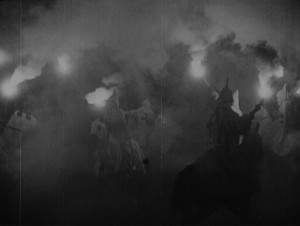 A word about musical accompaniment. Executive producer Paul D. Miller, who as a musician and cultural commentator goes by the moniker DJ Spooky, created a new musical score for two of the restorations that are in the Kino Lorber set, and commissioned new musical accompaniment for other restorations from other composers working in various jazz, classical, hip-hop, and techno-music settings. Miller says that “all the while a deep respect was maintained for the historical materials,” and doubtless it was. But the results often underscore how complicated the task is, whether historic silent films are to be viewed on large or small screens. Some of the new scores are effective, such as the now-late Max Roach’s drummed accompaniment to Oscar Micheaux’s The Symbol of the Unconquered: A Story of the KKK, from 1920 (image, left). But in the case of some other films, the accompaniment seems to ramble along, or stumble.
A word about musical accompaniment. Executive producer Paul D. Miller, who as a musician and cultural commentator goes by the moniker DJ Spooky, created a new musical score for two of the restorations that are in the Kino Lorber set, and commissioned new musical accompaniment for other restorations from other composers working in various jazz, classical, hip-hop, and techno-music settings. Miller says that “all the while a deep respect was maintained for the historical materials,” and doubtless it was. But the results often underscore how complicated the task is, whether historic silent films are to be viewed on large or small screens. Some of the new scores are effective, such as the now-late Max Roach’s drummed accompaniment to Oscar Micheaux’s The Symbol of the Unconquered: A Story of the KKK, from 1920 (image, left). But in the case of some other films, the accompaniment seems to ramble along, or stumble.
That cannot, however, spoil the pleasures and value of this extraordinary film package.
— Peter Monaghan
Disc One
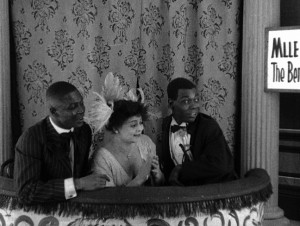 Two Knights of Vaudeville Ebony Film Co., 1915. 11 minutes. Music: Donald Sosin (left).
Two Knights of Vaudeville Ebony Film Co., 1915. 11 minutes. Music: Donald Sosin (left).
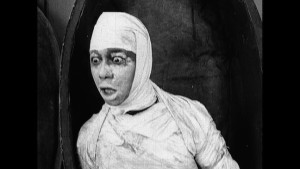 Mercy the Mummy Mumbled (Blu-ray only) Ebony Film Co., 1918. 12 minutes. Music: the Alloy Orchestra (right).
Mercy the Mummy Mumbled (Blu-ray only) Ebony Film Co., 1918. 12 minutes. Music: the Alloy Orchestra (right).
A Reckless Rover Ebony Film Co., 1918. 14 minutes. Music: Donald Sosin.
Within Our Gates Oscar Micheaux, 1920. 73 minutes. Music: Paul D. Miller, aka DJ Spooky.
T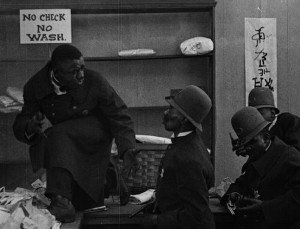 he Symbol of the Unconquered: A Story of the KKK Oscar Micheaux, 1920. 59 min. Music: Max Roach.
he Symbol of the Unconquered: A Story of the KKK Oscar Micheaux, 1920. 59 min. Music: Max Roach.
By Right of Birth Lincoln Motion Picture Co., 1921. 4 minutes. Music: Donald Sosin (left).
Body and Soul Oscar Micheaux, 1925. 93 min. Music: Paul D. Miller, aka DJ Spooky.
Screen Snapshots (Micheaux footage, 1920, 1 min.)
An Introduction (7 min.)
The Films of Oscar Micheaux (8 min.)
Disc Two
Regeneration Richard E. Norman, 1923. 11 min. Music: Donald Sosin.
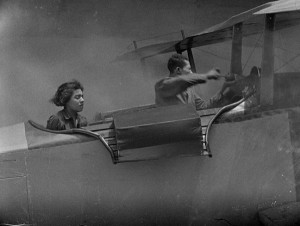 The Flying Ace Richard E. Norman, 1928. 65 min. Music: Mont Alto Motion Picture Orchestra (left).
The Flying Ace Richard E. Norman, 1928. 65 min. Music: Mont Alto Motion Picture Orchestra (left).
Ten Nights in a Bar Room CPFC, 1926. 64 min. Music: Donald Sosin.
Rev. S.S. Jones Home Movies Rev. Solomon Sir Jones, 1924-1926. 16 min. Music: Andrew Simpson.
The Scar of Shame Frank Peregini, 1929. 86 min. Music: Makia Matsumura
The Color Line (5 min.)
Ten Nights in a Bar Room – An Introduction (4 min.)
About the Restoration (8 min.)
Disc Three
Eleven P.M. Richard Maurice, 1928. 60 min. Music: Rob Gal.
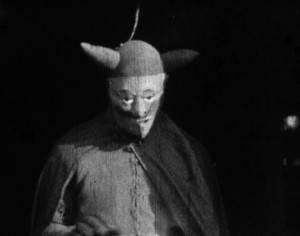 Hell-Bound Train James and Eloyce Gist, 1930. 50 min. Restored by S. Torriano Berry. Music: Samuel D. Waymon (left & below).
Hell-Bound Train James and Eloyce Gist, 1930. 50 min. Restored by S. Torriano Berry. Music: Samuel D. Waymon (left & below).
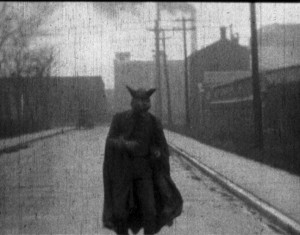 Verdict Not Guilty James and Eloyce Gist, 1934. 8 min. Restored by S. Torriano Berry. Music: Samuel D. Waymon.
Verdict Not Guilty James and Eloyce Gist, 1934. 8 min. Restored by S. Torriano Berry. Music: Samuel D. Waymon.
Heaven-Bound Travelers (Blu-ray only) James and Eloyce Gist, 1935. 15 min. Restored by S. Torriano Berry. Music: Samuel D. Waymon.
The Darktown Revue Oscar Micheaux, 1931. 18 min.
The Exile Oscar Micheaux, 1931. 78 min.
Hot Biskits Spencer Williams, 1931. 10 min.
Disc Four
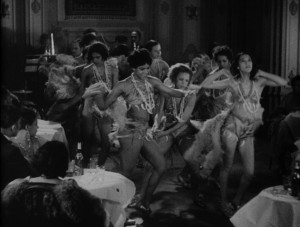 The Girl from Chicago Oscar Micheaux, 1932. 70 min.
The Girl from Chicago Oscar Micheaux, 1932. 70 min.
Ten Minutes to Live Oscar Micheaux, 1932. 58 min. (right).
Veiled Aristocrats Oscar Micheaux, 1932. 48 min.
Birthright Oscar Micheaux, 1938. 73 min.
Veiled Aristocrats Trailer (4 min.)
Birthright Trailer (4 min.)
We Work Again (Blu-ray only) WPA Documentary (1937, 15 min.)
Disc Five
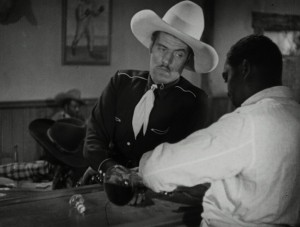 The Bronze Buckaroo Richard Kahn, 1939. 58 min. (right).
The Bronze Buckaroo Richard Kahn, 1939. 58 min. (right).
Zora Neale Hurston Fieldwork Footage (excerpt) Zora Neale Hurston, 1928. 3 min.
Commandment Keeper Church, Beaufort South Carolina, May 1940 (excerpt) Zora Neale Hurston, 1940. 15 min.
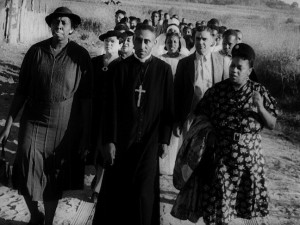 The Blood of Jesus Spencer Williams, 1941. 56 min. (left).
The Blood of Jesus Spencer Williams, 1941. 56 min. (left).
Dirty Gertie from Harlem U.S.A. Spencer Williams, 1946. 60 min.
Moses Sisters Interview Pearl Bowser, 1978. 32 min.
Texas Tyler Promo Film with Ossie Davis (1985, 6 min.)
The Films of Zora Neale Hurston (2 min.)
The Films of Spencer Williams (7 min.)
The End of an Era (4 min.)
Printed from Moving Image Archive News: http://www.movingimagearchivenews.org
URL to article: http://www.movingimagearchivenews.org/race-films-little-known-screen-gems/
Click here to print